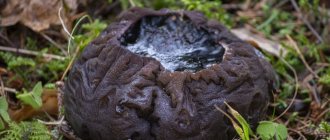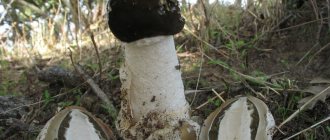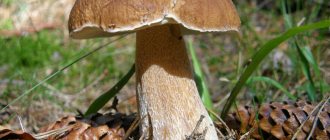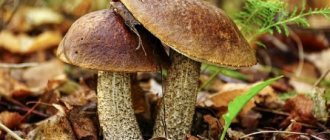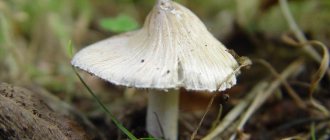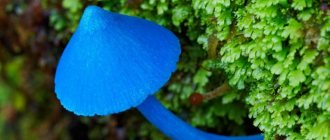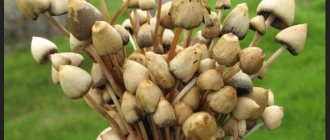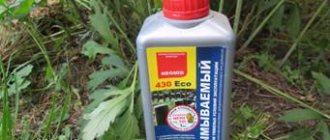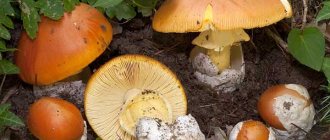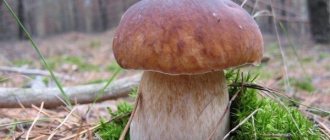Mushrooms
0
1414
Article rating
Kira Stoletova
Among the whole variety of mushrooms, there are those that are used for medicinal purposes; they can be both familiar in appearance and unusual to our eyes. One of them is the sarcosoma globulus fungus.
Description of the fungus sarcosome globular
DESCRIPTION
The mushroom looks quite peculiar. The fruiting body is at first almost spherical, immersed in moss, later opening, spherical or stretched upward, forming a “barrel”, usually 6-12 cm high and 3-8 cm in diameter (but can be much larger), soft. (In Europe it is called the “witch’s cauldron.”) The surface of the sides is dark brown or brown, smooth in young fruiting bodies, velvety in mature ones, really pleasant to the touch; When dry, it becomes wrinkled and folded. On top there is a glossy, shiny black disk on which the spore bags are formed, first concave, then flat. From the surface of this disk, once every 2-5 minutes, whole streams of spores shoot out, which are visible as whitish clouds; this is the first mechanism of reproduction. Rhizomorphs extend from the base of the mushroom - root-like strands up to several centimeters long. The fruiting body is filled with a transparent gelatinous liquid with spores (up to 30% of the total weight), odorless, and tastes like starchy water. The liquid contains sugars and mineral salts, which increase internal pressure in the fruiting body (this is why spores are periodically shot off). The mass of the mushroom together with liquid is usually 20-150 g, but can reach several hundred grams. If the weather is cool, liquid with ripened spores flows out through holes or cracks in the fruiting body, which softens with age, and this is the second mechanism of distribution. But if the weather is sunny, a third mechanism comes into force: by explosion. A mushroom overheated in the sun bursts, spraying its liquid contents far around.
Sarcosoma globosum
Sarcosoma globulus grows on mosses, litter of pine needles and litter, in old dark coniferous pine and spruce forests, on the edges of forests, along the edges of old forest roads, paths, and in overgrown clearings. Mushrooms are not always clearly visible, since they are often completely hidden in moss or litter and only the upper part of the fruiting body protrudes. Small groups of 5-10 fruiting bodies are usually found, but there are cases where populations number up to 300 or more individuals.
It is found in the temperate zone of the northern hemisphere, quite rarely on average. Fruits from late April to early June. In Russia, until about the last ten years, it was common in the southern taiga of Siberia, and in the European part - during the day with fire and a solid red book. But, apparently due to climate change, the fungus began to actively spread, and now finding it in the spring is a common thing. Sarcosoma is rarely prepared, it looks too strange. In general, it can be treated like an average marsupial mushroom. No pre-boiling required. In the Urals and Siberia it is stewed with potatoes.
Spreading
Sarcosoma is a saprophyte (i.e., it destroys dead remains of vegetation and living beings, converting them into simple substances) and grows in old coniferous forests (spruce and pine forests), preferring fallen pine needles, moss and thick grass. Rarely found in Central Europe, has an Arctic-Alpine distribution. They usually appear in the spring, when the snow begins to melt. The period of active growth occurs at the end of April - end of May. Globular sarcosoma, although it often grows singly, its population can be quite large - up to 100 pieces and occupy an area of approximately 4000 square meters. Sometimes they grow in numerous colonies (8 to 10 colonies).
Pharmacological and medical properties
A study of the chemical composition and active substances of the liquid and tissues of the sarcosome fruiting body showed that it contains 18 fatty acids, among which palmitic, stearic, heptadecanic and isoheptadecanic acids predominate. Amino acids were found in the tissues of fruiting bodies: glycine, cysteine, valine, histidine, lysine. The proteins contained a histone-like protein containing 70% of the amino acid arginine, as well as a protein - a brown pigment, similar to the brown pigment from chaga. Serious pharmacological studies and preclinical/clinical trials of the fungus have not been carried out, however, the already known medicinal properties of sarcosome and the identified chemical composition make this mushroom promising for studying its mycelial culture as a source of biologically active substances.
Sarcosoma globosum
Is it possible to grow it yourself?
It is worth noting that an abundant harvest of cams is sometimes possible at intervals of 3, 8 or even 10 years - this is what scientists say. However, some mushroom pickers claim that sarcosomes are harvested annually, and the number of fruiting bodies depends on weather conditions. But, unfortunately, trying to grow it in your garden or garden is not worth the time, labor, and most likely will not bring results, given the fact that it will be very difficult to provide the mushroom with a moss carpet and a sufficient amount of pine litter.
Traditional and folk medicine
In many regions of Russia, the use of sarcosome in folk medicine is known under the name “earth oil” (about the same as Veselka). In Russia and Belarus it is called a rejuvenating mushroom. The fresh liquid contained inside the fruiting body of the mushroom is used as a medicine. Its mushroom is taken on an empty stomach as a biostimulant and stimulant of mental activity, a general tonic, for a rejuvenating effect and as a sedative for gastritis and stomach diseases. The internal liquid and vodka tincture of the walls of the fruiting bodies are used externally to treat joint diseases, polyarthritis and rheumatism. To do this, the liquid or tincture is rubbed into the surface of the skin in places where the joints hurt. Intramuscular injections of sarcosome juice are used in the fight against cancer.
For medicinal and cosmetic purposes, the internal mucous contents of the fungus are applied to the scalp to improve nutrition of the hair roots and enhance their growth. Masks made from ground fresh walls of fruiting bodies are used to rejuvenate the skin.
Sarcosoma globosum
Doubles
Sarcosome, like many other fungi, has twins. They can be distinguished by certain characteristics, for example, by habitat, time of fruiting, or some differences in appearance.
Bulgariella pulla is a counterpart of Sarcosoma globulus. In appearance they are really similar, however, pulla grows on living tree branches, often on birch branches. It has a greenish-black color on the surface of the fruiting body.
Rules for collection and procurement for medicinal purposes
Fresh fruiting bodies are collected throughout the season, the liquid contents are used as an ointment, for internal use or for injections, the entire fruiting body itself or its walls is used for alcohol or vodka tinctures. The mushroom can be stored fresh in the refrigerator for a long time.
Since sarcosome grows only in a short spring period, and it is almost impossible to acquire it, storage problems arise with the liquid. You can prepare sarcosome mucus for long-term use in the following way.
Immerse seven or eight freshly picked mushrooms in medical alcohol for a few seconds, then place them on sterilely treated dishes. After 30-40 minutes, use a sterile knife to remove the upper part of the mushroom along with the disk, pump out the mucus from it with a syringe and release it into a previously prepared sterilized bottle (it should be tightly sealed). The mucus in the bottle is a medicine that should be stored in the refrigerator. Before each use, the mucus should be allowed to warm naturally to room temperature.
Dust bombs
Is the puffball mushroom edible or not?
Puffballs or Lycoperdon are a genus of mushrooms from the Champignon family. They are widespread in the forests of Central Russia, especially at sunset in summer, and are very well known not only to fans of quiet hunting, but also to most residents of the country, especially in the second stage of ripening, when the tissues of the mushroom dry out, and it bursts with any rough touch, exploding into a dark cloud of spore powder. In the old glorious times, Soviet children had a favorite pastime at the end of summer, walking around and “slapping” their ripe raincoats. At the same time, everyone knew that young white raincoats should not be touched, and also that they could be used to make soup.
Among the people, the raincoat has many original names - bomb, smoky, duster, puffer, tobacco mushroom, smoker, devil's tavlinka, golovach, wolf's tobacco, grandfathers, or grandfather's tobacco, and many others - similar. Moreover, these mushrooms are directly called puffballs, hare potatoes or bee sponges at an early stage of development, when their fruiting body is still dense and white. It is believed that this mushroom got its name from its tendency to grow especially wildly after rains.
RECIPES
Recipe for injections for cancer
The patient is given intramuscular injections into the buttock with the collected mucus (see above for the method of preparation and storage). The first week, with an interval of 3 days, 1 cm3 of the drug is injected at a time, the second week, 2 cm3 is injected every 3 days, the third - 3 cm3, and for the fourth and subsequent weeks, an injection is given once every 7 days, 1 injection with 3 cm3 sarcosome juice. The entire treatment course lasts 3 months. During treatment, it is necessary to strictly observe the intervals between injections and the recommended dosages.
Sarcosome mucus to improve hair growth and healthy scalp
Rub the internal fluid of the sarcosome, freshly collected or prepared using the above method, into the hair roots and scalp with massaging movements. Repeat the procedure daily in the morning for 7-10 days, then to complete the course once a week for a month.
Rejuvenating mask from the walls of the sarcosome fruiting body
After selecting the mucus, the walls of the fungus should be cut into relatively even fragments in the manner of orange peels. These “crusts” can be stored in the refrigerator for up to two weeks. Before use, you should make any cleansing mask to prepare the skin. After this, fragments of the sarcosome walls (if taken out of the refrigerator, then naturally heated to room temperature) should be placed as close to each other as possible on the skin of the face, mucous side down. The mask should be kept for about half an hour, after which remove the “crusts” and rinse your face with cool water. If the amount of mucus on the walls is sufficient, they can be put in the refrigerator and reused. With daily use, the rejuvenation effect is felt within a week.
Growing at home and in the country
You can grow a giant puffball mushroom yourself and feed the whole family with the edible fruit. To do this, spores with mycelium are purchased in specialized stores for breeding.
Mycelium is a fungal body in a vegetative state. Consists of thin threads with branches (hyphae).
Choose a shady place for planting: under trees and shrubs. The main condition is that the air temperature in this place should fluctuate between 14–29 °C. Of course, with the exception of winter time. A month after planting, the mushroom bears fruit every 20 days. Caring for the garden bed is easy: you only need watering to keep the soil moist.
How to grow:
- Loosen the planting area.
- Scatter the spores evenly.
- Cover the area with a layer of earth (about 7 cm).
- Water the garden bed thoroughly.
Use of a raincoat for medicinal purposes
Various medicinal products can also be prepared using mushrooms. The most common traditional medicine recipes are:
- Tincture. To prepare, you need to take enough raincoats so that they half fill a half-liter bottle. Fill the remaining volume of the container with vodka. The product must be infused for 40 days. Take a teaspoon of the product before going to bed. Tincture on raincoats helps well with diseases of the kidneys, liver, and stomach. Alcohol tincture of mushrooms is also used to treat cancer.
- Powder. Raincoats need to be dried in the sun, then ground into powder. The resulting product is used to disinfect open wounds. It is enough to sprinkle it on problem areas. The powder from raincoats can also be used to treat a runny nose by gently sucking it into the nostrils.
- A product for external use for skin diseases. To prepare it, you need to take vodka and plain water in a 1:1 ratio and mix. Pour the resulting liquid into a container (for example, a 1 liter jar) filled with mushrooms. Raincoats must be compacted tightly; their structure must collapse. The product should be infused in a dark, cool place for 14 days, after which you need to add 10 drops of lavender or tea tree essential oil.
Before you start preparing medicinal compositions, you need to carefully sort out the mushrooms and make sure that there are no false puffballs among them.
How to cook giant bighead?
You can add giant puffball to your diet, but only a white mushroom with white and elastic flesh. The shell is removed and the pulp is cut into layers. Layers of mushrooms can be fried in batter or breadcrumbs. This mushroom should not be cooked, as when cooked it acquires an unpleasant taste and absorbs a lot of water. Another way to eat mushrooms is by drying them. The raincoat dries very easily and quickly.
Preparation
Only young fruiting bodies with white flesh and a pleasant smell can be used for food. The pulp is cottony, and the taste is specific: somewhat reminiscent of feta cheese. Let's look at the most popular recipes.
Primary processing
Mushrooms are cleaned of forest debris, washed in a colander under running water, and allowed to drain. The shell is carefully peeled off with a knife, and the flesh is cut into slices.
Frying
Raincoat turns out very tasty in batter.
You will need:
- 1 kg of mushrooms;
- 2 chicken eggs;
- 5 tbsp. l. flour;
- 2 tbsp. l. vegetable oil for batter and 3 tbsp. l. for frying;
- a pinch of salt.
Preparation:
- Peel the mushrooms and cut into small slices. Add some salt.
- Mix flour, eggs, butter and make a batter. Mix well with a fork so that there are no lumps left.
- Heat a frying pan with sunflower oil.
- Dip the pieces into the batter and place them in the pan.
- Fry on both sides until a golden crust forms.
- Before eating, mushrooms are sprinkled with herbs.
Freezing
Freezing food significantly saves the housewife's time. With a minimum of effort, you can make preparations for various delicious dishes. For example, in the future it will be possible to prepare an excellent soup from mushrooms: the broth will be rich and satisfying, or you can add the fruits to fried potatoes or stew.
How to freeze correctly:
- Clean the mushrooms from forest debris and the top layer. Can't wash!
- Cut into small slices.
- Cover the cutting board with cling film. Place the pieces of raincoats evenly on it.
- Place in the freezer for 4 hours.
- After the time has passed, pack the mushrooms into bags.
- Now you can send the workpiece back to the freezer for long-term storage.
Attention! It is unacceptable to make several freezes for one serving. If the product has been thawed, it cannot be put back into the freezer.
Pickling
By stocking up on summer mushrooms for future use, you can make delicious pickles for the winter.
Ingredients:
- 2 kg of mushrooms;
- 5 pieces. onions;
- 150 g salt (not iodized);
- 1.5 tbsp. l. mustard seeds;
- 5 pieces. bay leaf;
- 10 pieces. peppercorns.
Cooking process:
- Thoroughly clean the mushrooms from any dirt. Wash under running water.
- Place raincoats in the pan. Fill with cold water to cover the fruit.
- Add 1 tsp. salt.
- Turn the heat to high and bring the liquid to a boil. When this happens, reduce the gas and cook for 7 minutes.
- Drain the water and leave the mushrooms to drain in a colander.
- Peel the onion and cut into half rings.
- Place onions and spices in sterilized jars. On top are boiled raincoats in thin layers. Be sure to add salt to each row.
- Pour boiling water into the jars filled with fruits.
- Roll up and turn the lid down.
- When the jars have cooled, transfer them to a cool place or refrigerator.
Side effects
Provided the dose and frequency of administration of Veselka mushrooms are observed, treatment is generally well tolerated. Occasionally, disruptions in the functioning of the gastrointestinal tract, such as bloating, nausea, diarrhea, are possible, in the event of which the use of the mushroom is stopped.
Leave your reviews about the Veselka mushroom, as well as proven recipes that have helped you or your loved ones.
Sources
- https://zdravotvet.ru/grib-veselka-lechebnye-svojstva-primenenie-kak-vyglyadit-kak-prinimat/
- https://gribnik.info/veselka-obyknovennaa/
- https://organicfact.ru/grib-veselka/
- https://gribysobiraem.info/vesyolka-grib/
- https://ferma.expert/griby/grib-veselka/
- https://poleznii-site.ru/lekarstvennye-rasteniya/lechebnye-svoystva-i-primenenie-griba-veselki-obyknovennoy.html
- https://domlech.ru/sredstva/115-veselka-grib
- https://naturopiya.com/fitoterapiya/udivitelnye-svojstva-griba-veselki-pri-lechenii.html
Interesting facts about the mushroom
- According to some scientists, sarcosome globulus is capable of fighting cancer cells.
- In some sources, sarcosome is classified as an inedible species of mushroom. But in some regions of Russia it is fried or stewed with potatoes. The dish is called “sarcosomnik”.
- It is believed that a rich harvest of cam can be harvested no more often. than once every 8-10 years. It is with this frequency that the fungus releases fruiting bodies.
- Earth oil has a unique composition that allows you to treat a wide variety of diseases, even cancer.
Sarcosoma is a mushroom that is not only rare in prevalence, but also extremely useful. Without knowing what it is and how it should be used, you can pass it by without risking putting it in your cart. Having an idea of its unique composition and properties, you hardly want to miss the chance to improve your health with the help of such a magnificent gift of nature.
Information sources
https://ru.wikipedia.org/wiki/Sarcosoma_spherical
Contraindications
Raincoat is not recommended for use as food, or as a raw material for the preparation of medicinal formulations in case of intolerance to the components that make up it, as well as during pregnancy and lactation, under the age of 7 years.
It is not recommended to eat raincoat for those who suffer from severe kidney pathologies.
The puffball mushroom is ubiquitous. It can be found not only in forests, but also in clearings, as well as along roads. When collecting these mushrooms, you need to be able to distinguish edible ones from false ones. You can use raincoats to prepare various dishes, as well as medicinal compositions.
0
0
Copy link
What diseases does Veselka treat?
- oncology of any organs, even at the last stage, destroys metastases and resolves tumors
- reduces the side effects of chemotherapy in cancer treatment
- any fungal infections (yeast, mold): candidiasis, aspergillosis, fungus of the skin, nails and other tissues. The most powerful antifungal agent!
- gastrointestinal diseases: gastritis, stomach and duodenal ulcers, constipation, bloating, flatulence, normalizes intestinal microflora, treats dysbiosis,
- pancreatic diseases
- cracked anus, hemorrhoids
- liver diseases, hepatitis A, B, C, cirrhosis
- kidney disease
- gynecology and women's health: cysts, fibroids, polyps, fibroids, infertility, hormonal imbalances, early menopause, endometriosis, cervical erosion, prevents diffuse and nodular mastopathy
- men's health: increases potency (erection), increases testosterone levels, diseases of the testicles (testicles), seminal ducts, prostatitis, prostate adenoma
- thyroid and endocrine diseases
- autoimmune diseases
- cardiovascular diseases, high cholesterol, thrombophlebitis, deterioration of blood composition and quality, varicose veins, post-stroke and post-infarction conditions, hypertension,
- skin diseases, psoriasis, neoplasms, dermatitis, eczema
- trophic ulcers
- brain and nervous system, epilepsy, encephalopathy, chronic fatigue
- joint diseases: radiculitis, rheumatism, gout
- HIV and AIDS
- herpes virus of all types (shingles, chickenpox, genital herpes, etc.)
- bacterial and viral infections
